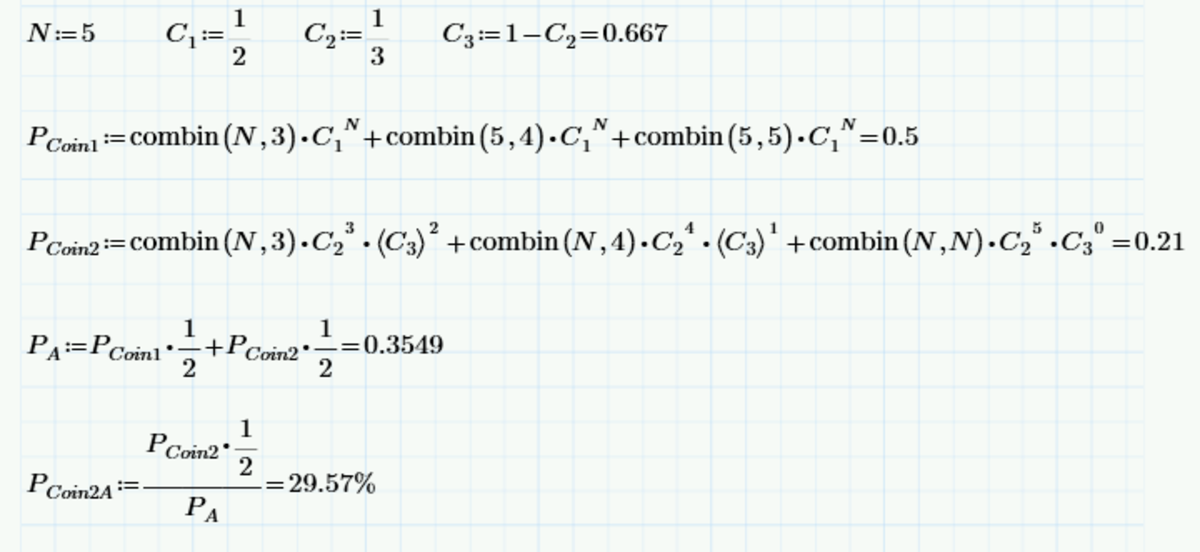Probability 3 Heads - Two Coins
There are two coins in a bag. The first coin is unbiased, whereas the second coin is biased with the probability of obtaining a head to be .
Your friend chooses one of the coins at random and tosses it 5 times.
You ask your friend, “Did you observe at least three heads?”
Your friend replies, “Yes.”
What is the probability that the second coin was chosen?
This section requires Javascript.
You are seeing this because something didn't load right. We suggest you, (a) try
refreshing the page, (b) enabling javascript if it is disabled on your browser and,
finally, (c)
loading the
non-javascript version of this page
. We're sorry about the hassle.

The following notation is used:
A t l e a s t t h r e e h e a d s − A 3 H C o i n 1 − C 1 C o i n 2 − C 2
Now, the probability of choosing coins 1 and 2 respectively are:
P ( C 1 ) = 0 . 5 P ( C 2 ) = 0 . 5
The probability of at least three heads given that coin 1 is chosen:
P ( A 3 H ∣ C 1 ) = ( 3 5 ) ( 2 1 ) 5 + ( 4 5 ) ( 2 1 ) 5 + ( 5 5 ) ( 2 1 ) 5 = 2 1
The probability of at least three heads given that coin 2 is chosen:
P ( A 3 H ∣ C 2 ) = ( 3 5 ) ( 3 1 ) 3 ( 3 2 ) 2 + ( 4 5 ) ( 3 1 ) 4 ( 3 2 ) 1 + ( 5 5 ) ( 3 1 ) 5 ( 3 2 ) 0 = 2 4 3 5 1
We are required to calculate the probability that coin C2 is chosen given that atleast three heads are observed. Essentially, we are asked to compute P ( C 2 ∣ A 3 H ) . This can be done using Baye's rule as follows:
P ( C 2 ∣ A 3 H ) = P ( A 3 H ) P ( A 3 H ∣ C 2 ) P ( C 2 )
Now:
P ( A 3 H ) = P ( A 3 H ∩ C 1 ) + P ( A 3 H ∩ C 2 )
Using the definition of conditional probability:
P ( A 3 H ) = P ( A 3 H ∣ C 1 ) P ( C 1 ) + P ( A 3 H ∣ C 2 ) P ( C 2 )
⟹ P ( C 2 ∣ A 3 H ) = P ( A 3 H ∣ C 1 ) P ( C 1 ) + P ( A 3 H ∣ C 2 ) P ( C 2 ) P ( A 3 H ∣ C 2 ) P ( C 2 ) = ( 2 1 × 2 1 ) + ( 2 4 3 5 1 × 2 1 ) 2 4 3 5 1 × 2 1 ≈ 0 . 2 9 5 6 5 2
In percentages, the probability evaluates to 2 9 . 5 6 5 2 %